The American State Papers

In today’s blog post we’ll look at the American State Papers (Papers). This collection consists of 38 physical volumes containing legislative and executive documents of Congress from 1789-1838. They include papers that cover the critical historical gap in the preservation of federal documents from the first presidency in 1789 to the printing of the first volume of the US Serial Set in 1817. The Serial Set picks up where the Papers leaves off and continues to this day.
Luckily for genealogists, these historical document sets are freely available on the Library of Congress web site A Century of Lawmaking For a New Nation: U.S. Congressional Documents and Debates, 1774-1873. Among the many items are the American State Papers (1789-1838) and the U.S. Serial Set (1817-1873). For more information, read this great article, “Those Elusive Early Americans: Public Lands and Claims in the American State Papers, 1789-1837.”
The American State Papers are divided into ten classes:
I. Foreign Affairs, 1789-1828: State of Union addresses; copies of treaties; correspondence; matters relating to commerce, navigation, finance, claims
II. Indian Affairs, 1789-1827: Treaty texts/accompanying documents; reports on Indian wars; documents concerning Indian trade
III. Finance, 1789-1828: Public debt/public credit; revenue/taxation; revenue collection
IV. Commerce and Navigation, 1789-1823: Imports/exports; light-houses; improvements of harbor/waterways; shipping tonnage; coastal trade
V. Military Affairs, 1789-1838: Army/militia organization; fortifications; War of 1812; other military operations
VI. Naval Affairs, 1789-1819: Officers/seamen; shipbuilding; explorations; naval operations
VII. Post Office, 1789-1833: Department organization; post roads; postal contracts; mail delivery; postage rates
VIII, Public Lands, 1789-1837: Bounty lands/grants; preemption titles; land sales; corporate land claims
IX. Claims, 1789-1823: Petitions for extra pay; compensation for services; losses due to military/government action
X. Miscellaneous, 1789-1823: Contested congressional elections; admission of new states; state boundaries; slavery issues; other subjects not covered in I-IX
The Public Lands and Claims volumes are considered to be the most genealogically valuable volumes in the Papers series because they deal heavily with individuals. However, this should not stop you from checking out other volumes in the series. In fact, depending on the claim, you might find a person in more than one class in the series
So what kinds of genealogical information might you find in the Public Lands document collection? More than you might think…
- Placement of ancestor in particular place at particular time
- Clues to death dates
- Information lost in courthouse fires
- Ages of land claimants
- Previous residences
- Names of children, wives, and other relatives
- Specific location of claims
- Time period of “cultivation and habitation”
…and in documents you might not even know exist!
- Petitions of inhabitants
- Discussions of litigation surrounding validity of claims
- Documentation of arrivals into geographic areas
- Land cessions and annexations
- Discussions of neighbors and associates
- More detailed information than land-entry case files
- Settlement of claims under previous sovereigns
- Pre-emption rights
- Homestead settlements
- Military bounty lands and militia claims
- Contractual agreements with several Indian nations
- Settlement of claims by refugees
- Cases of fraud
- Statements of land sold by land offices
- Claims by surveyors for compensation
- Legal descriptions of land
Public Lands
The public domain (public land) is land owned by the federal government, who can sell or transfer such land under laws passed by Congress. It includes western lands that the original states ceded to the US as well as acquisitions from foreign governments. Congress was therefore initially responsible for many matters relating to the settlement of land in the public domain. Here we have the example of John Baptiste Brunett, who lawfully entered a claim on public land in Michigan Territory. Two witnesses, Pierre Carboneau and John Baptiste Longevin, confirm the length of time he lived there and that he met the requirements for legally acquiring that land (Fig. 1). If this was your ancestor, you would note the land location, the witnesses, adjacent property owners, and the justice of the peace; remember the FAN club discussed in the previous blog post!
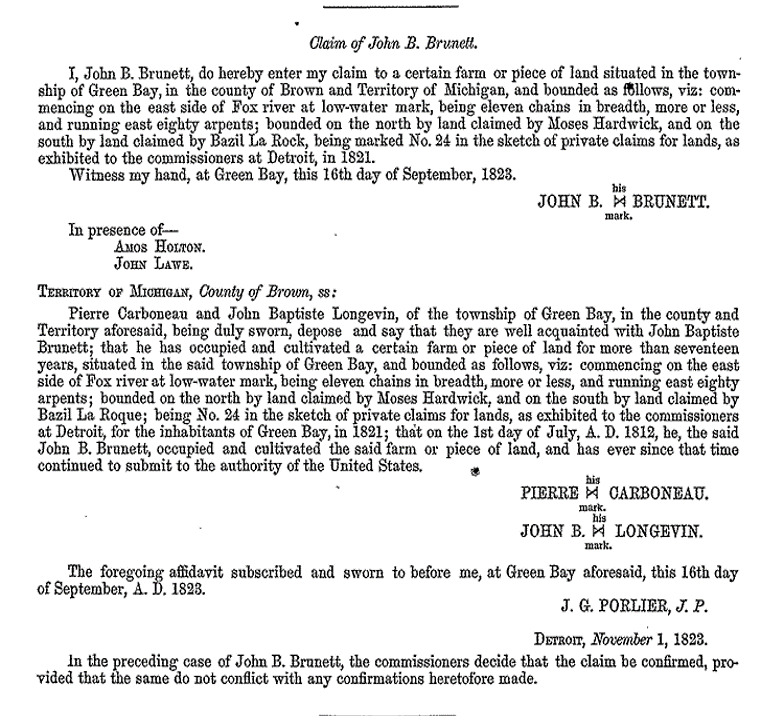
In another case, the US government sold some Miami Indian reservation land by mistake that had been reserved to Mary Wells, a half-blood Miami Indian, and she and her husband James Wolcott petitioned to reclaim the land. However, the property had since been developed by the purchasers and had proven to be economically valuable (Fig. 2). The petitioners were amenable to conveying the land to the US for $3 an acre, and that the Indian Affairs Committee believed it would be a matter of “good policy” and governmental justice for the US to do so. You can see the bill here.
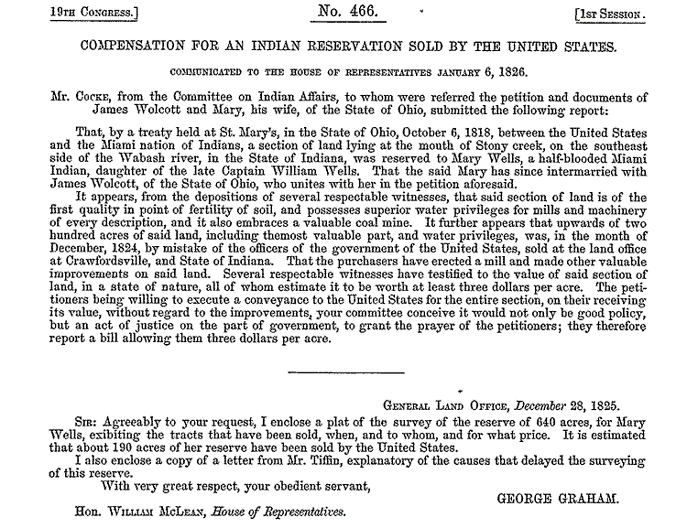
Claims
The Claims volumes exist because of the constitutional mandate that Congress was to pay all US debts. It was to assume many responsibilities in overseeing and settling adjudication of all claims against US, including a wide array of non–land-related claims from 1789-1823. These include pensions, compensation for property destroyed by the enemy, relief of army contractors, militia claims, compensation for wages, and other unique situations. The claimant would first appeal to the Treasury. If the claim was rejected, his or her only recourse was to appeal directly to Congress, usually through a local person of influence or their congressional representative.
The Claims prove particularly valuable in the case of pre-1800 Revolutionary War pensions, which burned in a fire in the War Department on November 8, 1800. Much information on pre-1800 applicants would have been lost if the secretary of war had not sent War Department reports to Congress between 1792 and 1795 that were based on original applications. The lists for 1792, 1794, and 1795 were printed in the Claims volume; they contain name, rank, disability, date and location where disabled, residence, pension entitlement, and other remarks.
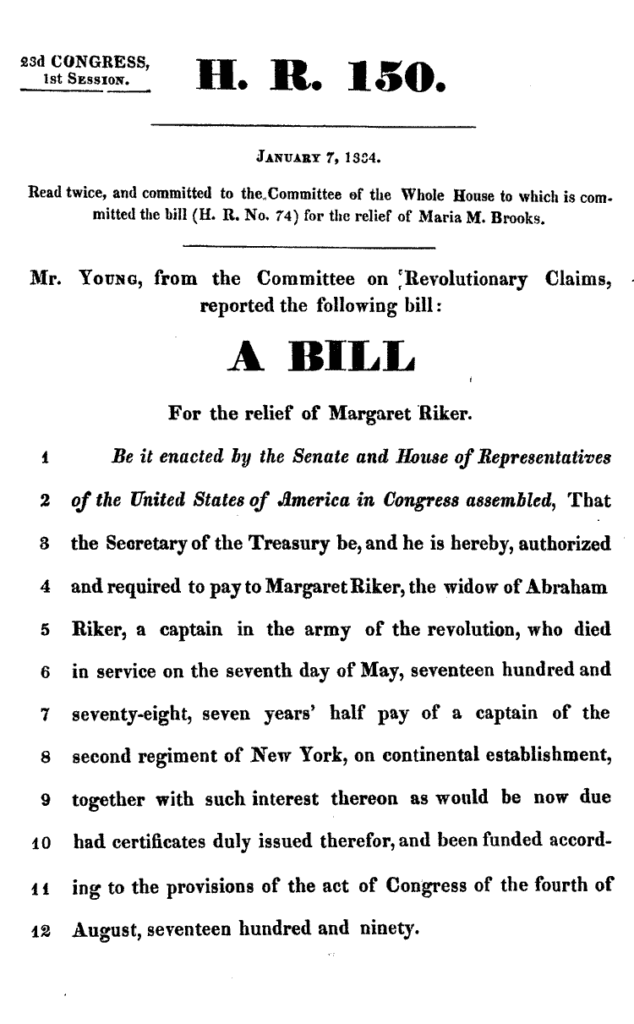
Margaret Riker, widow of Captain Abraham Riker, was one of those claimants. On February 27, 1794, her petition for half-pay for Abraham’s war service was read to the House, but it wasn’t until January 7, 1834 (Fig. 3) that the actual a bill on her behalf was referred to the whole House, and not passed by both houses until June 28, 1834! Margaret’s dogged persistence earned her the pension and preserved this genealogical gem: Abraham Riker was a captain of the Second New York Regiment who died on May 7, 1778.
Let’s look at the claim submitted by Josiah H. Webb, whose claim story spans both the Papers and the US Serial Set. Josiah was a post rider carrying mail from Coweta, Georgia to Fort Stoddert in Mobile, Alabama when he was shot and severely wounded by an unknown person in the Creek Nation in August 1805. The fort postmaster Edmund P. Gaines sent a letter requesting the Post Office for compensation for Josiah’s care (Fig. 4).
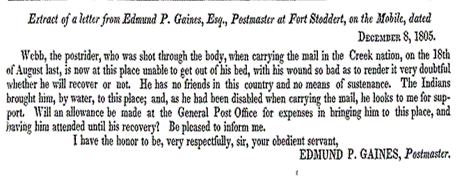
Gaines’s request was communicated to Congress by John Cotton Smith from the Committee of Claims on March 29, 1806 (Fig. 5). The bill submitted on his behalf went through a number of readings in House and Senate for approval before it was passed in his favor.
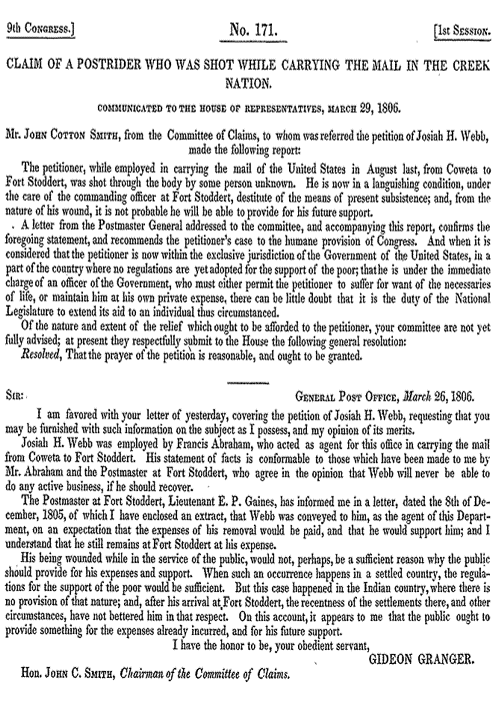
On April 21, 1806, Congress appropriated $250 to defray the cost of his care while recuperating at Fort Stoddert (Fig. 6). In 1811 a bill for Josiah’s relief was passed by Congress and signed by President James Madison on December 12, 1811 (Fig. 7). He was to receive $50 annually.



Depending on the type of claim, you may find additional data in other Papers volumes that relate to information found in the Claims volumes. In Josiah’s case, he was a postal employee, so information about him was also sought from the Post Office. Other influential individuals were also sought out to help bolster Josiah’s case (Fig. 8).
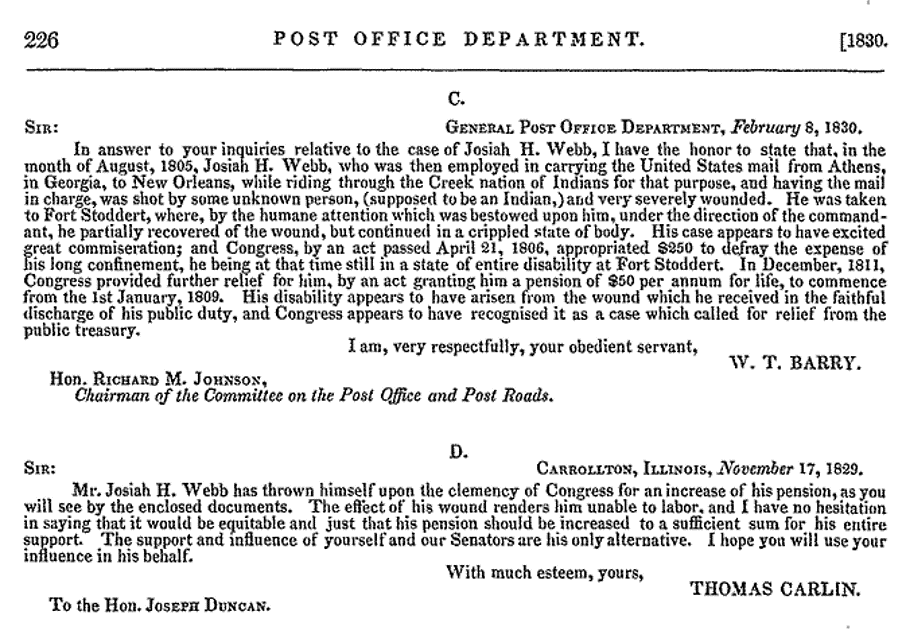
Josiah asked for additional relief in February 1830 because his present allowance of $50 a year was inadequate for his needs. To bolster his claim, several persons signed and submitted a petition on his behalf. The Committee on Post Offices and Roads decided to give Josiah $8 per month, the same as a disabled common soldier. (Fig. 9).
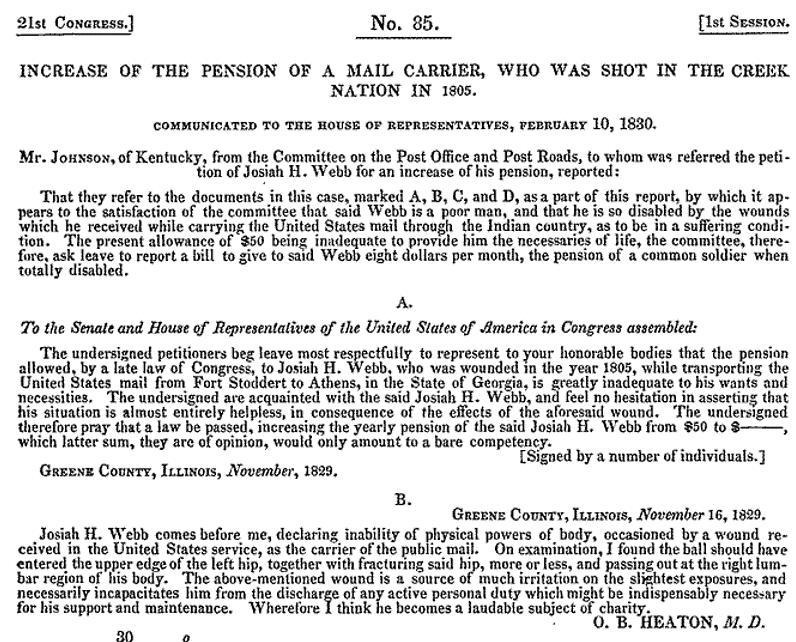
On February 10, 1830 a bill for Josiah Webb’s relief in the form of payment of $96 a year for life was read twice and sent to the House of Representatives (Fig. 10), which rejected it on February 5, 1831. Josiah petitioned again for an increase in mid-December 1831, which was once more referred to the Committee on Post Offices and Roads. On December 28, 1831 the Committee reported on the petition, again recommending the typical $8 per month paid to a common soldier, This was accompanied by a bill (No. 153, not located) for his relief, which was read twice and referred to the House the next day.
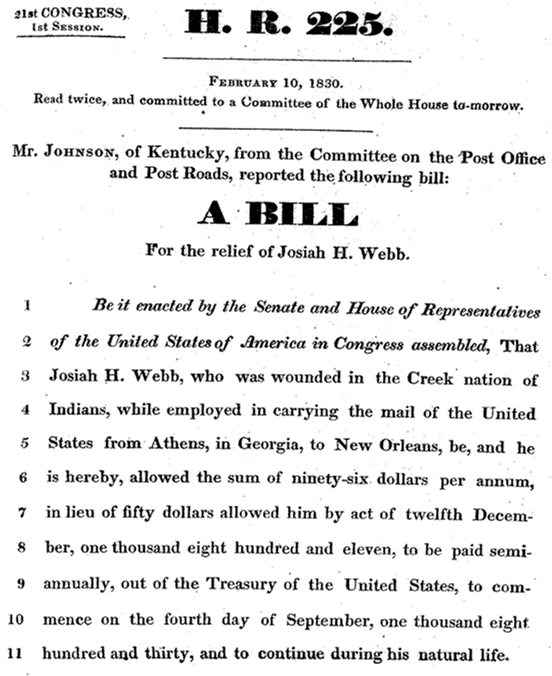
On April 9, 1832, the engrossed bill passed the House, meaning that it was in its final or definitive form. It passed the House on April 10, and on April 12 the Senate referred “An Act for the Relief of Josiah H. Webb” to the Committee of Pensions. This committee referred the bill to the Committee of Post Offices and Roads on April 16.
No further information was located regarding the saga of Josiah H. Webb’s claim in the American State Papers and the US Serial Set, but the process of following his story with the available documentation demonstrates the importance of examining every appearance of a person’s name. Josiah’s claim involved the Claims and Post Office classes of the Papers. James and Mary Wolcott’s claim appeared in the Public Lands and Indian Affairs classes.
If you find a claim in the American State Papers, you can also contact the Center for Legislative Archives at the National Archives for assistance in finding more information on the claim in congressional records. There may be more to a person’s case than what you first discover, such as original petitions and supporting documentation in House and Senate committee files at the Center. Contact the Center for Legislative Archives, National Archives and Records Administration, 700 Pennsylvania Avenue NW, Washington, DC 20408-0001. You can also call 202-357-5350 or e-mail them at legislative.archives@nara.gov.
If your ancestor submitted a claim between 1789 and 1817, you should follow its course through both houses of Congress and even into the Serial Set if necessary. Doing your due diligence in these records could provide you with very rewarding results.


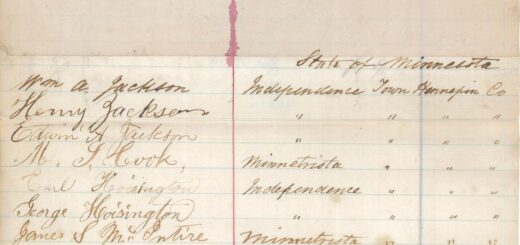
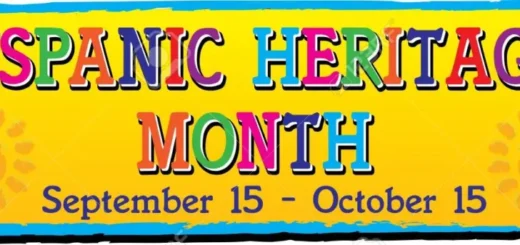

Recent Comments